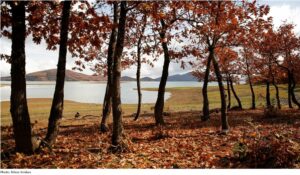A little before 7 am, I lowered my feet onto the thick, warm rug by my bed. Some light from the village of Agios Athanasios crept through the window diagonally to form a shadow of the wooden veranda onto the room ceiling.
The windows were still foggy with condensation, heavy drops of dew running down slowly as a reminder of the contrast in temperatures inside and outside. I opened the door shutters purposefully, despite the cold, as my day slowly got underway. At this hour, the sky was just beginning to turn blue; it was cloudy but not raining and the scent of the moist earth filled my lungs.
Mutehe scent of the moist earth second floor of the Titagion hotel – where I spent the night following a long drive covering countless kilometres across northern Greece ahead of my trip’s eventual drive south, back to Athens – the eastern side of the Tavropos lake, or Plastiras, as the lake is commonly known, faded into the hazy autumn horizon.
The route around Lake Plastiras, approximately 50 km long, is a winding course offering dense nature, traditional villages and houses, elegant guesthouses, tantalisingly delicious food whose recipes are rooted in the region at local tavernas and restaurants, as well as places ideal for recreational activities and the exploration of nature.
The manmade Tavropos (Megdovas) Lake, or Lake Plastiras as it is commonly known, takes its name from Nikolaos Plastiras, a general and politician who envisioned the project that ended with the completion of a dam at Kakavakia in 1959.
source travel.gr
author and photo credit Nikos Kokkas




Ask me anything
Explore related questions





